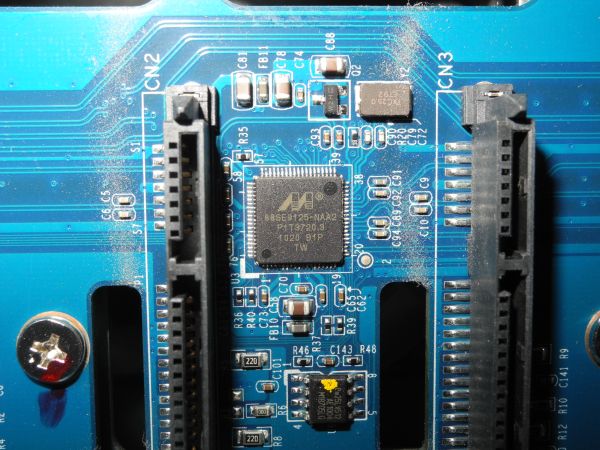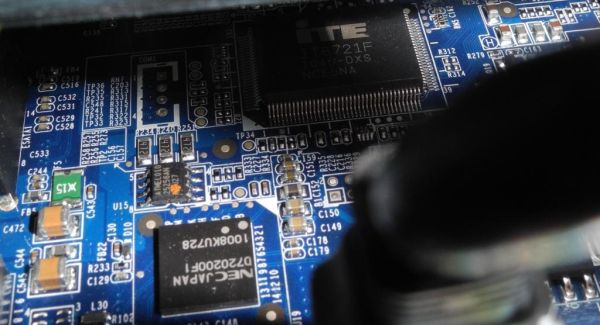QNAP TS-659 Pro II Review
by Ganesh T S on September 19, 2011 8:00 AM EST- Posted in
- IT Computing
- NAS
- QNAP
The host silicon in the SMB / SOHO NAS market is primarily from two players. While the low end is dominated by Marvell, the high end is dominated by Intel's Atom processors. As one goes higher, we have even more powerful Intel CPUs (such as the low end Core i3s). Freescale used to have some design wins till 2009 with their PPC based processors, but we haven't seen any units based on their processors in their last two years.
Removing the drive bays of the TS-659 Pro II reveals an array of 6 SATA slots and a couple of Marvell 88SE9125 chips [PDF]. These are SATA to PCI-E bridges, with support for 2 SATA devices. We believe another of these bridge chips must be present on the other side of the SATA slots array. This array connects to the PCI-E bus on the ICH9 southbridge.
Most of the high end SMB / SOHO NAS units have 1 GB of RAM which can be expanded. The TS-659 Pro II also has 1 GB of RAM expandable to 3 GB. In order to install this notebook memory, one needs to open up the unit. The brushed steel top can be removed by taking off the screws at the rear end and sliding the top out. The motherboard is covered by a screwed on plastic film with a flap above the SODIMM slot where the user can put in the additional memory.
The rest of the components are not easily accessible, but we did manage to grab a snap of the Renesas-NEC 720200 USB 3.0 to PCI-E bridge which enables the two USB 3.0 ports on the unit. The iTE IT8721F is the hardware monitor sensor and fan control chip.
In the next section, we will have the testing methodology outlined and also a description of the testbed.













69 Comments
View All Comments
jmelgaard - Monday, September 19, 2011 - link
I Use the PS3 Media Server instead of the built-in one to stream to a PS3.I must admit I have not tried streaming directly to my Sony DLNA enabled TV as I have gotten to use to using the PS3.
But it might be worth trying to see if it narrows the cases where the format is unsupported.
saiga6360 - Monday, September 19, 2011 - link
You will probably run into the same issue, which is really a Sony issue not supporting media formats. In which case, you will be stuck with a PC in between your storage and media player. As NAS hardware continue to upgrade to more powerful CPUs then maybe a better integrated DLNA media server can become possible.jmelgaard - Tuesday, September 20, 2011 - link
The point is that the PS3 has the same issue, many formats are unsupported by the PS3.The PS3 media server is therefore aimed to transcode unsupported medias to a format that the PS3 supports, so this should narrow the cases unless it chooses to transcode into a format that a TV does not support.
There is a bunch of settings for the various encoders, but to what degree you can control what is transcoded by default and what the output is I don't know.
jmelgaard - Tuesday, September 20, 2011 - link
Oh and the whole point of choosing the PS3 media server over any others was just that it already has a Pre-build QPKG for QNAP users making the installation a blizz...For other NAS types it's a different story.
jwcalla - Monday, September 19, 2011 - link
I'm somewhat surprised by the (relatively) poor NFS performance. Were the hard disks left in ext4 configuration or formatted to NTFS before the tests?ganeshts - Monday, September 19, 2011 - link
NFS performance could be improved by playing around with the mount options. We just tabulated the values at the default settings. The disks were in EXT4 only.Sivar - Monday, September 19, 2011 - link
A know of several businesses looking for something just like this. Your article was not only well-written and informative, you also have a clue about image formats so didn't use JPEG, which is horribly inefficient for screen shots like the ones in the article.SeeManRun - Monday, September 19, 2011 - link
Hi Ganesh,I read the article as I am very interested in getting a NAS or building my own. One thing that appears to be a limit for all of these machines is the speed at which you can transfer data from them. It seems to me with dual gigabit ethernet ports bonded, you should be able to see above 110 megabytes per second. I have read on smallnetbuilder that almost no NAS can get above this limit. Do you happen to know why, or care to explore this?
Thanks
tbutler - Monday, September 19, 2011 - link
Question that wasn't answered in the review: are the eSATA ports on this box compatible with port multipliers?ganeshts - Monday, September 19, 2011 - link
Thanks for bringing this to my attention.I just checked it out myself and am able to confirm that the eSATA ports are compatible with port multipliers.